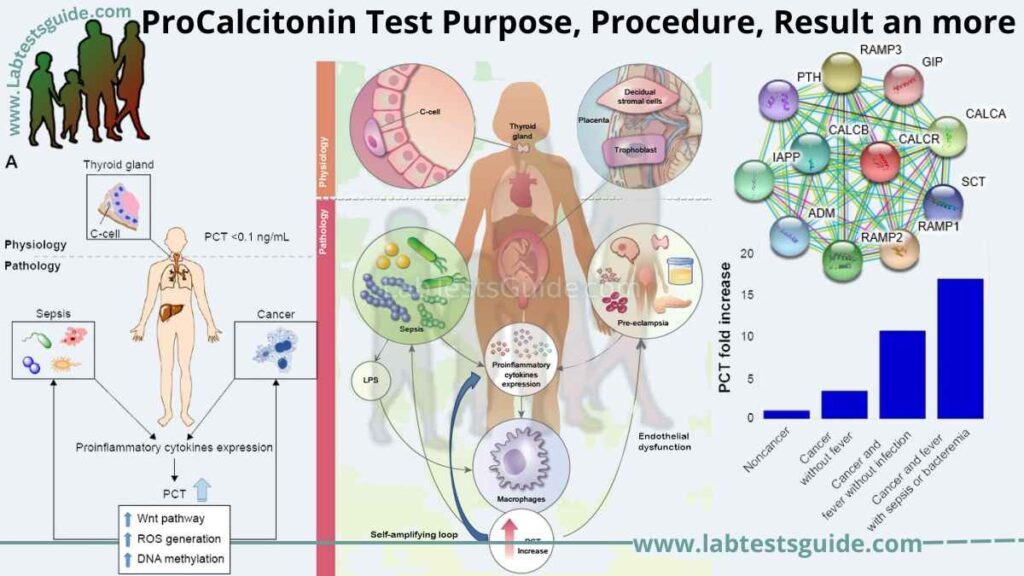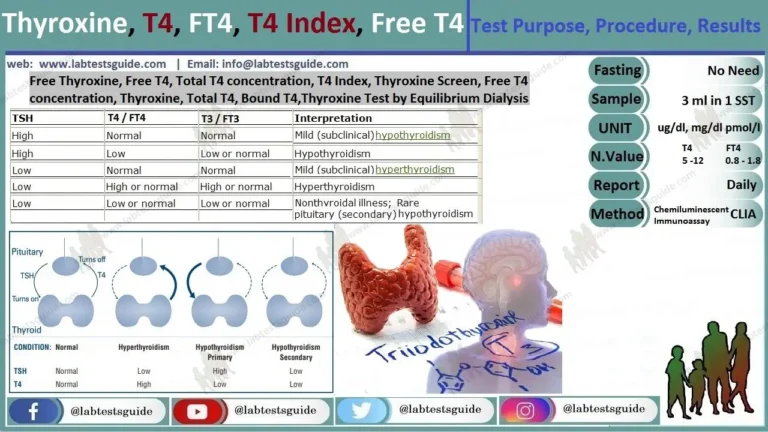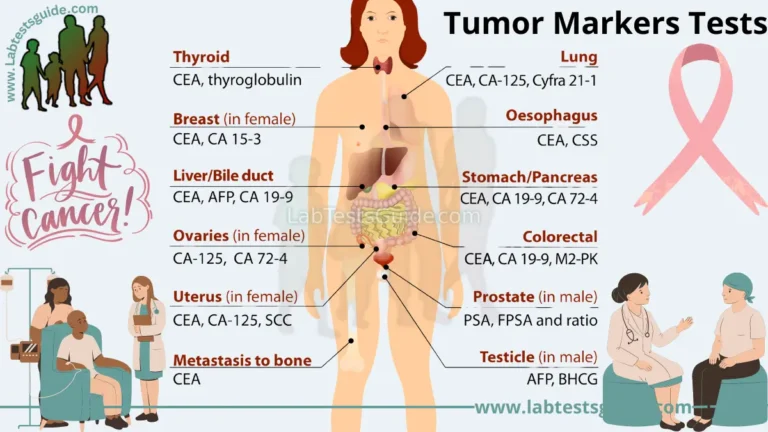Procalcitonin Test Purpose, Procedure, Result and more
The Procalcitonin test is a blood test that measures the level of procalcitonin, a protein that is produced by the body in response to bacterial infections. Elevated levels of PCT can indicate the presence of a bacterial infection, such as sepsis or pneumonia. The test is used to help diagnose and monitor the severity of these infections, as well as to determine the appropriate course of treatment. It is also used to differentiate between bacterial and viral infections. The test is typically used in critically ill patients in the hospital setting.

What is Procalcitonin ?
Procalcitonin (PCT) is a protein that is produced by the body in response to bacterial infections. PCT is primarily produced by the thyroid gland and is a precursor to the hormone calcitonin. Elevated levels of PCT in the blood can indicate the presence of a bacterial infection, such as sepsis or pneumonia. PCT levels typically rise within hours of the onset of a bacterial infection and can remain elevated for several days or weeks. The PCT test is used to help diagnose and monitor the severity of bacterial infections and to determine the appropriate course of treatment. It is also used to differentiate between bacterial and viral infections.
What is the purpose of Procalcitonin test ?
- To help diagnose and confirm the presence of a bacterial infection, such as sepsis or pneumonia.
- To monitor the severity of bacterial infections and to determine the appropriate course of treatment.
- To differentiate between bacterial and viral infections, as PCT levels typically rise quickly in response to bacterial infections but do not typically increase in response to viral infections.
- To decide whether or not to start antibiotics and how long to continue treatment.
- To monitor the effectiveness of antibiotic treatment and to determine when it is safe to discontinue antibiotics.
- To monitor patients who are at high risk for bacterial infections, such as those with compromised immune systems or chronic conditions.
- To detect any potential recurrences of the infection after treatment.
- To monitor critically ill patients in the hospital setting.
- To help to decide when it is safe to discharge a patient from the hospital.
- As a marker of sepsis and as a prognostic marker for critically ill patients.
When to get Procalcitonin tested ?
- When a patient is suspected of having a bacterial infection, such as sepsis or pneumonia.
- When a patient is critically ill and at risk for a bacterial infection.
- When a patient has been treated for a bacterial infection and the healthcare provider wants to monitor the effectiveness of treatment and detect any potential recurrences.
- When a patient has a compromised immune system or a chronic condition that increases the risk of bacterial infections.
- When a patient has a fever and signs or symptoms of infection but the cause is uncertain, and the healthcare provider wants to differentiate between bacterial and viral infections.
- When a patient is being treated with antibiotics and the healthcare provider wants to monitor the patient’s response to treatment.
- When a patient is being discharged from the hospital and the healthcare provider wants to ensure that the infection has been effectively treated.
- As a marker of sepsis and as a prognostic marker for critically ill patients.
Please note that it’s always best to consult with a healthcare professional to determine whether or not a PCT test is necessary for a specific patient.
Procalcitonin Test Preparation :
Procalcitonin (PCT) test preparation typically involves fasting for several hours before the test. This means that the patient should not eat or drink anything, except for water, for a certain period of time before the test. The time frame for fasting before the test can vary depending on the laboratory or healthcare provider. It’s always best to check with the healthcare provider or laboratory regarding the specific fasting requirements before the test.
Additionally, it’s important to inform the healthcare provider of any medications that the patient is currently taking, as some medications may interfere with the test results.
The PCT test is a simple blood test and no special preparation is needed. The patient will have a small amount of blood drawn from a vein in the arm, usually the inside of the elbow or the back of the hand. The blood is then sent to a laboratory for analysis.
Overall, the preparation for PCT test is minimal and straightforward. The patient should follow the instruction provided by their healthcare provider or the laboratory, and inform the healthcare provider of any medications they are currently taking.
Sample Required for Procalcitonin Test :
2 mL (1 mL min.) Serum from 1 SST.
The sample required for a Procalcitonin (PCT) test is typically a small amount of blood, which is collected by a healthcare professional through a simple blood draw procedure. The blood is typically drawn from a vein in the arm, usually the inside of the elbow or the back of the hand.
Normal Values :
Procalcitonin (PCT) test normal ranges can vary depending on the laboratory or healthcare provider. Generally, normal PCT levels in healthy adults are considered to be less than 0.5 ng/mL. However, some laboratories use a lower cut-off point of 0.1 ng/mL.
Source 1:
- < 0.5 ng/ml
Source 2
- Adults and children > or =72 hours: < or =0.15 ng/mL
- Children < 72 hours: <2.0 ng/mL at birth, rises to < or =20 ng/mL at 18-30 hours of age, then falls to < or =0.15 ng/mL by 72 hours of age
In general, PCT levels are considered to be elevated when they are above the normal range, indicating the presence of a bacterial infection. The higher the PCT level, the more severe the infection is considered to be.
However, it’s important to note that the normal range for PCT can also vary depending on a person’s age, sex, and overall health. For example, in children, normal PCT levels are generally lower than in adults.
It’s always best to consult with a healthcare professional or refer to the test results to determine the specific normal range for a particular patient or laboratory. Also, it’s important to note that PCT test should be used in combination with other clinical and laboratory data to make a diagnosis and monitor the treatment.
Procalcitonin level increases in :
Procalcitonin (PCT) levels can increase in a variety of conditions and diseases, including:
- Bacterial infections: PCT levels typically increase quickly in response to bacterial infections such as sepsis, pneumonia, meningitis, and urinary tract infections.
- Sepsis: PCT levels are considered as a marker of sepsis, and a high PCT level can indicate a severe case of sepsis.
- Pneumonia: Pneumonia is an infection of the lungs, which can be caused by bacteria, viruses, or other microorganisms. PCT levels typically increase in response to bacterial pneumonia.
- Meningitis: Meningitis is an inflammation of the protective membranes that cover the brain and spinal cord, and PCT levels can increase in response to bacterial meningitis.
- Urinary tract infections: PCT levels can increase in response to bacterial urinary tract infections.
- Other types of infections: PCT levels can also increase in response to other types of bacterial infections, such as osteomyelitis, endocarditis, and bacteremia.
- Trauma: PCT levels can also increase in response to severe trauma and burns, as well as in response to certain types of surgery.
- Cancer: PCT levels can be elevated in some types of cancer, such as lung, colon and thyroid cancer.
It’s important to note that PCT test should be used in combination with other clinical and laboratory data to make a diagnosis and monitor the treatment.
Procalcitonin level Decreases in :
Procalcitonin (PCT) levels typically decrease in response to treatment of a bacterial infection or in the absence of an infection. Here are some examples of situations where PCT levels may decrease:
- Successful treatment of a bacterial infection: PCT levels typically decrease as the infection is brought under control and the body’s immune response subsides.
- Antibiotic treatment: PCT levels typically decrease as the patient receives appropriate antibiotic treatment for the infection.
- Recovery from infection: PCT levels will decrease as the patient’s body successfully fights off the infection.
- No infection present: PCT levels will be normal or low in patients without an active infection.
- Viral infections: PCT levels do not typically increase in response to viral infections, and therefore levels will remain low or normal in cases of viral infections.
It’s important to note that PCT test should be used in combination with other clinical and laboratory data to make a diagnosis and monitor the treatment. Also, PCT level can be affected by many other factors such as age, sex, pregnancy, medication, and chronic diseases. So, it’s always best to consult with a healthcare professional to interpret the results in the context of the patient’s individual clinical situation.
Conclusion:
In conclusion, the Procalcitonin (PCT) test is a blood test that measures the level of procalcitonin, a protein that is produced by the body in response to bacterial infections. Elevated levels of PCT can indicate the presence of a bacterial infection, such as sepsis or pneumonia. The test is used to help diagnose and monitor the severity of these infections, as well as to determine the appropriate course of treatment. It is also used to differentiate between bacterial and viral infections. The test is typically used in critically ill patients in the hospital setting.
The PCT test is a simple blood test that requires minimal preparation, such as fasting before the test. The normal range for PCT levels can vary depending on the laboratory or healthcare provider, but generally, normal levels are considered to be less than 0.5 ng/mL. PCT levels are considered to be elevated when they are above the normal range, indicating the presence of a bacterial infection.
PCT levels can increase in response to a variety of conditions, including bacterial infections, sepsis, pneumonia, meningitis, urinary tract infections, and other types of infections. PCT levels can also increase in response to severe trauma and burns, as well as in response to certain types of surgery. PCT levels typically decrease in response to treatment of a bacterial infection or in the absence of an infection.
It’s important to note that PCT test should be used in combination with other clinical and laboratory data to make a diagnosis and monitor the treatment. Also, PCT level can be affected by many other factors such as age, sex, pregnancy, medication, and chronic diseases. So, it’s always best to consult with a healthcare professional to interpret the results in the context of the patient’s individual clinical situation.
FAQs
Here are some frequently asked questions about Procalcitonin (PCT) tests:
What is procalcitonin?
Procalcitonin (PCT) is a protein that is produced by the body in response to bacterial infections. PCT is primarily produced by the thyroid gland and is a precursor to the hormone calcitonin. Elevated levels of PCT in the blood can indicate the presence of a bacterial infection, such as sepsis or pneumonia.
What is a procalcitonin test used for?
The PCT test is used to help diagnose and monitor the severity of bacterial infections and to determine the appropriate course of treatment. It is also used to differentiate between bacterial and viral infections. The test is mainly used in critically ill patients in the hospital setting.
How is a procalcitonin test done?
The PCT test is a simple blood test that requires minimal preparation, such as fasting before the test. The test involves drawing a small amount of blood from a vein in the arm, usually the inside of the elbow or the back of the hand. The collected blood sample is then sent to a laboratory for analysis.
What are the normal ranges for procalcitonin levels?
Normal PCT levels in healthy adults are considered to be less than 0.5 ng/mL. However, some laboratories use a lower cut-off point of 0.1 ng/mL. The normal range for PCT can also vary depending on a person’s age, sex, and overall health.
What do high procalcitonin levels indicate?
Elevated levels of PCT can indicate the presence of a bacterial infection, such as sepsis or pneumonia. The higher the PCT level, the more severe the infection is considered to be.
Can procalcitonin levels be affected by other factors?
Yes, PCT level can be affected by many other factors such as age, sex, pregnancy, medication, and chronic diseases. So, it’s always best to consult with a healthcare professional to interpret the results in the context of the patient’s individual clinical situation.
Is the PCT test the only test used to diagnose and monitor bacterial infections?
No, PCT test is not the only test used to diagnose and monitor bacterial infections. It should be used in combination with other clinical and laboratory data to make a diagnosis and monitor the treatment. Other diagnostic tests may include blood cultures, urinalysis, chest x-ray, or computed tomography (CT) scans.
Home | Blog | About Us | Contact Us | Disclaimer
Possible References Used




